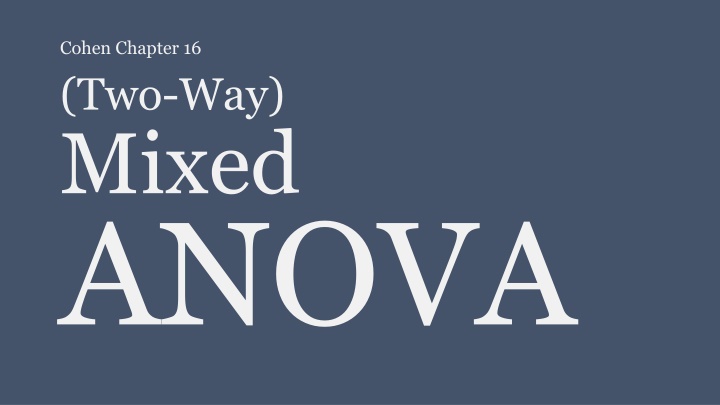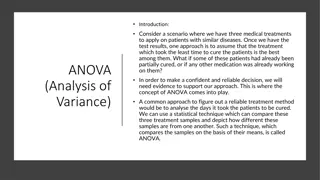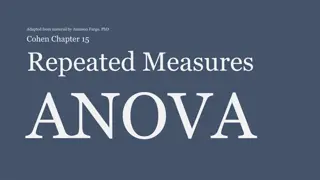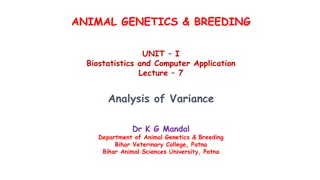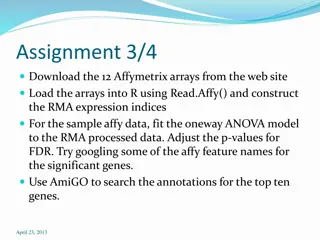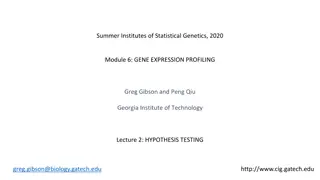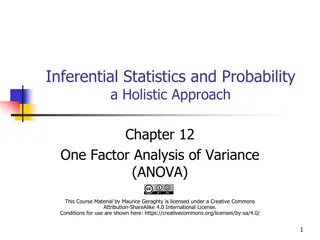Design of Mixed ANOVA in Research
Using a Mixed ANOVA design in research involves factors like repeated measures, between-subjects variables, and understanding how to analyze within-subjects variability. The design allows for comparing different treatments at various time points and exploring the impact of independent variables on the outcome. By considering factors such as groups, individual participant characteristics, and the nature of the study, researchers can gain valuable insights into the relationships between variables and make informed conclusions.
Download Presentation

Please find below an Image/Link to download the presentation.
The content on the website is provided AS IS for your information and personal use only. It may not be sold, licensed, or shared on other websites without obtaining consent from the author.If you encounter any issues during the download, it is possible that the publisher has removed the file from their server.
You are allowed to download the files provided on this website for personal or commercial use, subject to the condition that they are used lawfully. All files are the property of their respective owners.
The content on the website is provided AS IS for your information and personal use only. It may not be sold, licensed, or shared on other websites without obtaining consent from the author.
E N D
Presentation Transcript
Cohen Chapter 16 (Two-Way) Mixed ANOVA
There are only two mistakes one can make along the road to truth; not going all the way, and not starting. Buddha
Dr. Professor is interested in determining whether the average man wants to express his worries to his wife more (or less) the longer they are married. However, it may depend on at what age the man was when he became married. So Dr. Professor administers the Expression scale at 1 year, 5 years, and 10 years after marriage and, at baseline, finds out the man s age at marriage (categorical with older, middle age, and younger). What is the repeated-measures (within-subjects) factor and what are its levels? What is the between-subjects factor and its levels? What is the outcome variable? Dr. Test wishes to compare reaction time differences for the three subtests of the Stroop Test in patients with Parkinson s Disease: Color, Word, and Color Word. Dr. Test believes that any differences may be influenced by the sex of the individual. What is the repeated-measures factor and what are its levels? What is the between-subjects factor and its levels? What is the outcome variable? 3
The Design of Mixed ANOVA Just like in One-Way RM ANOVA Just like in One-Way ANOVA Time 2 Time t Time 1 Group 2 Time t Time 1 Time 2 Groups Sample (between-subjects) Randomize sample to k groups (experiment) Individuals self-select groups (quasi- experimental) Use matched or repeated measures for each group Time t Time 2 Time 1 (can have different treatments, different treatment times) 4
The Design of Mixed ANOVA When there is repeated measures for one of the factors but not for the other Time 2 Time t Time 1 Group 2 Time t Time 1 Time 2 Groups Sample (between-subjects) Randomize sample to k groups (experiment) Individuals self-select groups (quasi- experimental) Use matched or repeated measures for each group Time t Time 2 Time 1 (can have different treatments, different treatment times) 5
Independent Variables (predictors) Between-Subjects Factor Within-Subjects Factor Independent Groups Participants belong to only ONE Repeated Measures Participants have ALL levels contin_var ~ group_var + (rm_var | id) 6
Analyzing: Between-Subjects Variability Simple RM Design Mixed Design Assess and Test Assess and Test general pattern across time (or condition) general pattern across time (or condition) and subject-to-subject differences due to the independent groups Subject-to-subject variability Some is due to the difference in the levels of the between-subjects factor Subject-to-subject variability Ignored it all: it is assumed to just be error 7
Analyzing: Within-Subjects Variability We already have seen the calculation of an F ratio for the main effect of the repeated measures when we analyzed the one-way RM ANOVA This F can now be recalculated to take into account the separation of subjects into subgroups (between-subjects factor), which decreases the error term. The numerator of FRMwon t change The denominator will change Most of the S RM interaction is really due to a group condition interaction, which should be removed from the total S RM interaction. 8
Assumptions: Mixed ANOVA Restriction: Only Can Include Participants with ALL levels of the RM factor (complete cases) Independence SUBJECTS are independent of each other Equal Spacing If the repeated measures is time Normality OUTCOMES (dependent variable) for each condition combination should be sampled from a normally distributed population Homogeneity of Variance Each population (condition combination) should have the same error variance Sphericity Same as before (essentially all individuals have similar patterns of change across conditions/time) but after accounting for any between-subjects factors 9
